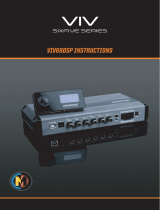
Table of Contents
1. Introduction...................................................................................................................................... 1-1
Product Model Information ...................................................................................................................1-2
Product Features ................................................................................................................................1-2
Inside the Box....................................................................................................................................1-2
Product Specifications .........................................................................................................................1-2
Physical Dimensions............................................................................................................................1-7
Hardware Reference............................................................................................................................1-7
Panel Guide ................................................................................................................................1-7
LED Indicators ............................................................................................................................1-7
2. Initial Setup ...................................................................................................................................... 2-1
Hardware Installation ..........................................................................................................................2-2
Connecting the Power ..................................................................................................................2-2
Grounding the ioLogik E1200 ........................................................................................................2-2
Connecting to the Network ...........................................................................................................2-2
Jumper Settings ..........................................................................................................................2-2
I/O Wiring Diagrams ....................................................................................................................2-3
Software Installation ...........................................................................................................................2-4
Load Factory Default ...........................................................................................................................2-5
3. Using the Web Console...................................................................................................................... 3-1
Introduction to the Web Console...........................................................................................................3-2
Overview ...........................................................................................................................................3-2
Network Settings ................................................................................................................................3-3
General Settings .........................................................................................................................3-3
Ethernet Configuration .................................................................................................................3-4
User-defined Modbus Addressing ..........................................................................................................3-4
User-defined Modbus Addressing...................................................................................................3-4
Default Address ..........................................................................................................................3-4
Active OPC Server Settings ..................................................................................................................3-5
I/O Settings .......................................................................................................................................3-5
DI Channels................................................................................................................................3-5
DO Channels...............................................................................................................................3-6
AI Channels ................................................................................................................................3-7
AO Channels...............................................................................................................................3-9
RTD Channels ........................................................................................................................... 3-10
TC Channels ............................................................................................................................. 3-11
System Management......................................................................................................................... 3-12
IP Accessibility .......................................................................................................................... 3-12
Network Connection .................................................................................................................. 3-13
Firmware Update....................................................................................................................... 3-13
Import System Config ................................................................................................................ 3-13
Export System Config ................................................................................................................ 3-13
Peer-to-peer Settings ........................................................................................................................ 3-14
Peer-to-peer Settings (1-50) ...................................................................................................... 3-14
Sample Configuration ................................................................................................................ 3-14
DO Safe Mode Settings .............................................................................................................. 3-15
Change Password ............................................................................................................................. 3-15
Load Factory Default ......................................................................................................................... 3-16
Save/Restart.................................................................................................................................... 3-16
4. Using ioSearch .................................................................................................................................. 4-1
Introduction to ioSearch ......................................................................................................................4-2
ioSearch Main Screen ..........................................................................................................................4-2
Main Screen Overview..................................................................................................................4-2
Main Items ........................................................................................................................................4-2
System ......................................................................................................................................4-2
Sort...........................................................................................................................................4-3
Quick Links.................................................................................................................................4-4
Main Function.....................................................................................................................................4-4
Locate .......................................................................................................................................4-4
Firmware Upgrade .......................................................................................................................4-4
Unlock .......................................................................................................................................4-5
Import .......................................................................................................................................4-5
Export .......................................................................................................................................4-6
Change IP Address ......................................................................................................................4-6
Restart System ...........................................................................................................................4-6
Reset to Default ..........................................................................................................................4-7























